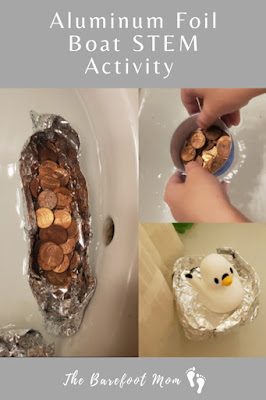We love STEM activities in this house. My oldest is definitely a hands on learner so we try to incorporate a lot of hands on activities into our homeschool days. In this post I will share instructions and resources for a really fun STEM activity we did recently: Aluminum Foil Boats!
Learning About Boats And Buoyancy:
Before we got started on our own boats we spent some time learning about boats and researching how boats float. Here are a few good resources we found:
Why Do Ships Float? from SciShow Kids
How Do Boats Float? from Fun Kids Inspiring Engineers
How Boats Float from Boat Safe Kids
I also did a quick Google Image search so we could look at pictures of different types and shapes of boats.
Why Do Ships Float? from SciShow Kids
How Do Boats Float? from Fun Kids Inspiring Engineers
How Boats Float from Boat Safe Kids
I also did a quick Google Image search so we could look at pictures of different types and shapes of boats.
Building And Testing Aluminum Foil Boats:
Once we felt like we had a good understanding of what a boat needs to look like to float, I challenged my kids to design and build their own boats out of aluminum foil.
My 7 year old decided to make a row boat shaped boat, a canoe, and two different types of rafts. My toddler just had fun playing with the foil.
When they were done, I had my daughter write a quick hypothesis about which boat she thought would float best and hold the most weight. Then we filled up the kiddie pool in the backyard and tested them out!
We added pennies to see how much weight each boat could hold and recorded it in a notebook. My daughter's row boat shaped boat held the most weight. It held 90 pennies.
After we were finished my daughter wrote a short conclusion in her notebook and we talked about why we thought the rowboat shape worked best. Our thoughts are it's wide bottom makes it more stable than the canoe shape and it's high sides allow it to displace more water than the raft shape.
If you enjoyed this post check out:
Follow me on:





This is a great idea! I love to do STEM activities with my Granddaughter.
ReplyDeleteI love this idea! I am a huge fan of turning something so small into something that's hours worth of fun!
ReplyDeleteThat's awesome. My kids love STEM projects and we will have to try this one.
ReplyDeleteSo cute! I will have to try this with my boys!
ReplyDeleteThis is a very good idea
DeleteSuch a fun lesson! My boys did something just like this in a class they took at our local children's museum. They had a blast and I bet your daughter did too. Thanks so much for sharing with us at Love to Learn. Pinned.
ReplyDelete